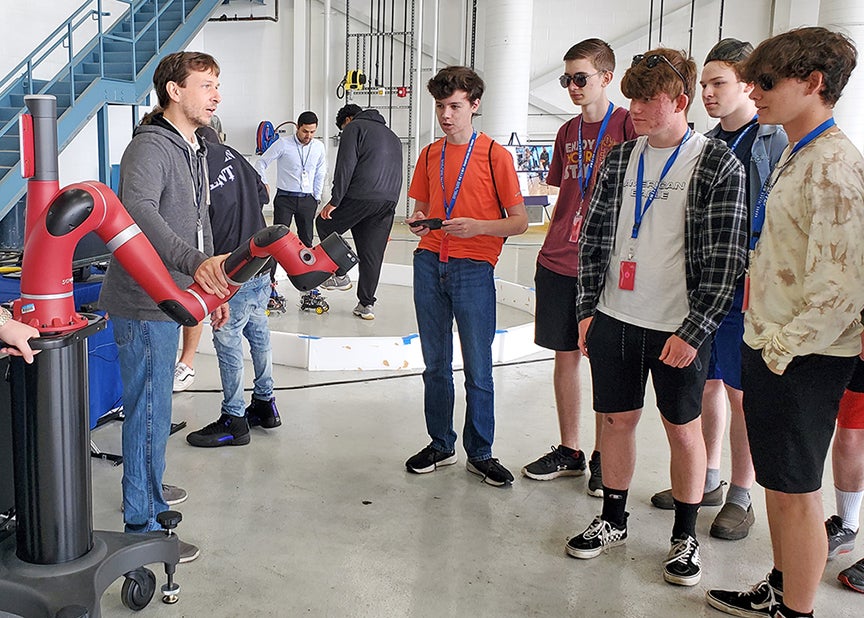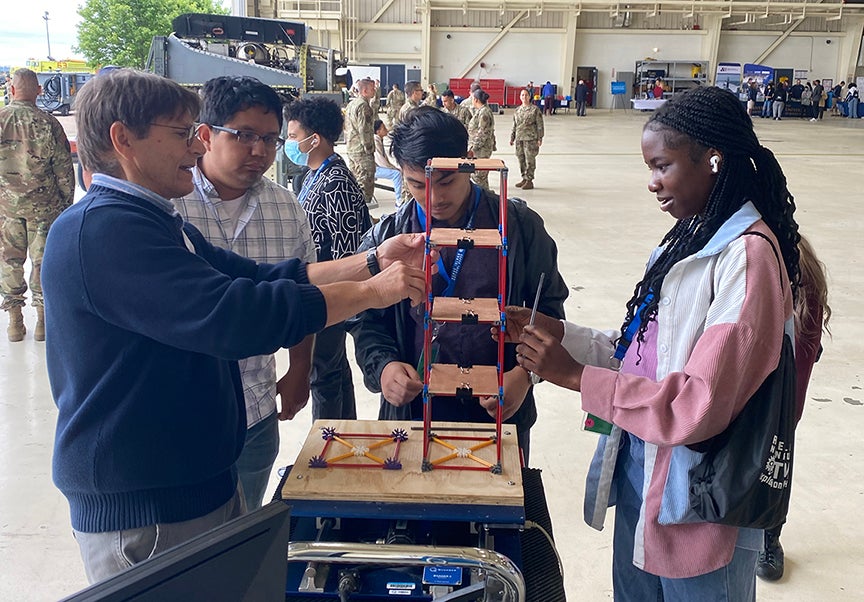KINGSTON, R.I. – June 20, 2022 – University of Rhode Island faculty members volunteered to present exhibitions at a STEM Exploration Open House hosted by the Rhode Island National Guard at its Quonset base earlier this month. The event exposed Rhode Island high school students to the various career and educational opportunities in the fields of science, technology, engineering and math.

Engineering Professor Mayrai Gindy served as the URI coordinator for the event, working with 2nd Lt. Patricia Testa, associate athletic director for business and personnel for URI Athletics, who was the lead coordinator for the National Guard. Gindy recruited faculty from engineering, pharmacy, chemistry and the Graduate School of Oceanography, who brought a total of 16 interactive exhibits to share with the students. Along with University faculty, other organizations in attendance included Electric Boat, WindWinRI, New England Tech, Civil Air Patrol, the Explosives Operations Division of the Office of the State Fire Marshal and Raytheon.
Among the University faculty members in attendance was Brennan Phillips, an assistant professor of ocean engineering who has a joint appointment with the Graduate School of Oceanography. Phillips, whose research revolves around deep sea robotics and ocean exploration, brought low-cost deep ocean exploration technologies to show students at the event.
“Because it’s so low-cost, it’s really accessible for students,” he said, “In our case, it’s usually undergraduates, but I’ve had high school students involved in our research in the past as well.”
In his laboratory, he takes students who have little to no background in the field and trains them in 3D modeling and printing, electronics and coding on these low-cost devices.
“Bringing that to the National Guard event was a really great thing, because those are the students we’re trying to recruit,” he said. “Those are kids who may be interested in engineering [and] we can show them what we’re doing in the ocean and say [that they’ll] actually be able to make a lot of this stuff [themselves] as a student here.”
Chemical Engineering Professor Otto Gregory brought his ‘digital dog nose’ technology, which was originally designed to be worn by soldiers to warn them of threats such as toxic gas. Following the Sept. 11, 2001 attacks, the focus shifted to the detection of improvised explosive devices (IEDs), and in recent years the research has expanded to include biological toxins. Some of the devices now can detect diabetes by examining the glucose in a person’s breath, or help determine if a person has COVID-19. Gregory showcased these new health care applications at the event.
“We weren’t allowed to tell them anything other than [showing] them their results, and then we threw them away,” he said. “We [showed] them what their breath looks like, though, doing this kind of analysis, which was fun for them.”
At the event, while he didn’t go into too much detail about the way the device works, he expressed to the students that this can do “pretty much what a dog can do.”
“Dogs are the gold standard, but they can only work for an hour and a half before they need a break,” he said, “compared to our device that just sits there and works 24/7.”
Paolo Stegagno, an assistant professor of electrical, computer and biomedical engineering whose research focuses on mobile robotics, brought two interactive exhibits to the event: one with two small ground robots, and the other with a robotic arm.
The ground robots, he explained, move by themselves and are able to avoid anything in their paths. The students engaged with the robot by trying to block it or catch it while it attempted to escape from and evade them. Students also interacted with the arm, which was developed in collaboration with fellow Engineering Professor Chengzhi Yuan.
“I hope that some of these kids will come to URI in the future, or at least engage in STEM,” he said. “They were shy, a little bit, but I had some very positive interactions. Some kids really tried to play with the robots and I had students asking questions about the arm.”
Engineering Professor George Tsiatas, brought a computer-controlled tabletop shake-table for students to test models they made with K’NEX building toys.
“We started by showing a 4-story ‘building’ with small resistance at the connections between beams and columns, but this did not perform well,” he said. After a few rounds of adjustments, the structure performed better.
He noted that the students were interested in seeing in real-time how the structural changes led to better performance, and that they spent a lot of time making their own buildings, some of which were tested.
Pharmaceutical Sciences and Chemical Engineering Professor Jie Shen, who works on creating advanced drug delivery systems to treat difficult-to-manage diseases, brought with her virtual reality (VR) headsets and gaming laptops for students to experience “how different types of nanoparticles (such as liposomes for COVID vaccines) are produced in the lab.”
“We developed nanotechnology lab molecules in both VR and 3D gaming modules to introduce emerging technologies such as nanotechnology to students in a fun and more interactive way,” she said.
Some of Shen’s students helped at the event.
“My students and I really enjoyed interacting with high school students at the event,” she said. “They asked about what we do in the lab. They were very interested in and excited about the VR and 3D gaming learning tools available at URI.”
While each of the faculty members in attendance have different research areas and responsibilities, they all agree that events like this are very important in engaging the next generation of STEM professionals.
“One of the motivations for why I did robotics was because I wanted to play with robots at work, so a career goal was actually to have fun in what I was doing,” Stegagno said. “By showing the interactive demonstrations, we hope they had fun, and [that] they may consider a career in STEM as a viable option for the future.”
“We had students there from all over the state and from high schools that don’t necessarily engage in ocean sciences and ocean tech,” Phillips said, “and I think this is exactly the type of stuff we need to do more of.”
Gregory noted that these events are important for both students and, in this case, the military.
“It’s important for the high schools and the students themselves to know what opportunities are out there and how science can actually help people,” he said, “[and] it’s important for the military in this case because there are military applications and the military saw the benefits of our device.”
The research and development of the digital dog nose was originally funded by the Defense Advanced Research Projects Agency and the Department of Defense and most recently by the Department of Homeland Security.
Shen also noted that, in addition to introducing high school students to STEM concepts, this event also showcased what URI is able to do as the state’s flagship public university.
Gindy, who works in the same research lab as Tsiatas, said that events like this are “critical” for exposing young adults to STEM careers and the impact that the field has on people’s day-to-day lives.
“They can help solve some of the problems facing society now and in the future, and at the same time get personal satisfaction for enhancing the quality of life in Rhode Island and beyond,” said Tsiatas, whose research focuses on the behavior of buildings and other structures when subjected to forces such as earthquakes and wind.
The event, which drew roughly 500 students, was a smashing success.
“I saw lots of smiling faces and looks of amazement,” said Gindy. “We received great feedback from students. One student said this was ‘the coolest thing he’s been to in his life.’”
Mary Lind, a graduate student in URI’s Department of Marketing and Communications, wrote this news release.

